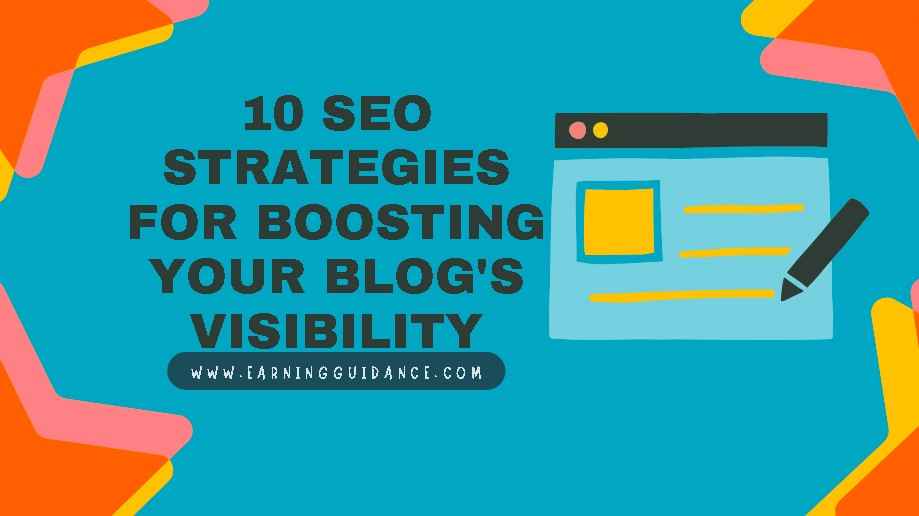Table Of Contents
- 1 SEO Strategies for Boosting Your Blog’s Visibility
- 2 Introduction
- 3 Understanding Search Engine Optimization
- 4 Keyword Research and Optimization
- 5 On-Page SEO Techniques
- 6 Off-Page SEO Strategies
- 7 Technical SEO Optimization
- 8 User Experience and Engagement Signals
- 9 Content Creation and Optimization
- 10 Local SEO Strategies
- 11 Measuring and Analyzing SEO Performance
- 12 FAQs
- 13 Conclusion
SEO Strategies for Boosting Your Blog’s Visibility
Note: This article is a comprehensive guide on SEO strategies that can significantly improve the visibility of your blog. Throughout the article, you will find valuable information and actionable tips to optimize your blog for search engines and attract more organic traffic.
Introduction
In today’s digital landscape, where numerous blogs compete for attention, SEO plays a crucial role in ensuring your blog stands out and reaches its target audience. This article aims to provide you with a deep understanding of effective SEO strategies that can boost your blog’s visibility and help you achieve greater success.
Mastering the Art of Writing Engaging Blog Posts
Understanding Search Engine Optimization
Search Engine Optimization (SEO) is a fundamental aspect of digital marketing that focuses on improving a website’s visibility and organic (non-paid) traffic from search engine results pages (SERPs). With millions of websites competing for attention, SEO strategies help businesses and individuals rank higher in search engine rankings, resulting in increased visibility, web traffic, and potential customers. This section provides an overview of SEO, including its role in boosting blog visibility, search engine algorithms, ranking factors, and key concepts related to SEO.
Introduction to SEO
Search Engine Optimization (SEO) is the practice of optimizing a website to improve its visibility and organic search rankings on search engines like Google, Bing, and Yahoo. It involves various techniques, strategies, and best practices that help search engines understand and rank websites based on their relevance to user queries. SEO is essential for boosting the visibility of blogs and driving targeted organic traffic.
Search Engine Algorithms and Ranking Factors
Search engines use complex algorithms to determine the order in which websites appear in search results. While the exact algorithms are closely guarded secrets, there are known ranking factors that influence search engine rankings. Some important ranking factors include:
- Relevance: Search engines assess the relevance of a website’s content to a user’s search query. Websites with high-quality, relevant content tend to rank higher.
- Keywords: Keywords play a crucial role in SEO. By researching and strategically using relevant keywords in website content, meta tags, and headings, you can improve your chances of ranking higher for specific search queries.
- Backlinks: Search engines consider the number and quality of websites linking back to your blog as a measure of its authority and credibility. High-quality backlinks can positively impact your search rankings.
- User Experience: Factors such as website speed, mobile-friendliness, ease of navigation, and overall user experience contribute to search engine rankings. Search engines prioritize websites that provide a positive user experience.
- Content Quality: Creating high-quality, valuable content that satisfies user intent is crucial for SEO. Well-written, informative, and engaging content tends to attract more organic traffic and helps with higher search rankings.
How to Choose the Perfect Blogging Platform for Your Needs
Key Concepts and Terminology
To effectively navigate the world of SEO, it’s essential to understand key concepts and terminology. Here are a few important terms to know:
- SERP (Search Engine Results Page): The page displayed by a search engine in response to a user’s query, which includes a list of relevant websites.
- Organic Search Results: The non-paid search results that appear on a SERP, typically below the sponsored ads.
- Keywords: Words or phrases that users type into search engines when looking for information. Keyword research helps identify relevant keywords for optimizing website content.
- On-Page Optimization: The process of optimizing various elements on a web page, such as meta tags, headings, content, and URL structure, to improve its visibility and relevance to search engines.
- Off-Page Optimization: Activities conducted outside of your website to improve its visibility, such as building backlinks, social media marketing, and guest blogging.
- Crawling and Indexing: Search engine bots (crawlers) scan and analyze web pages to understand their content. If deemed relevant and valuable, the pages are indexed and included in search engine databases.
Understanding these concepts and terms will provide a solid foundation for implementing effective SEO strategies to boost your blog’s visibility and drive organic traffic.
External Link: To dive deeper into understanding SEO, you can refer to this comprehensive guide on SEO basics by Moz.
Keyword Research and Optimization
Keyword research and optimization are critical components of SEO that help improve a blog’s visibility and attract targeted organic traffic. By identifying and strategically incorporating relevant keywords into your blog content, meta tags, headings, and URLs, you can increase your chances of ranking higher in search engine results. This section explores the importance of keyword research, tools and techniques for conducting keyword research, and optimizing blog content with relevant keywords.
Importance of Keyword Research
Keyword research is the process of identifying the specific words and phrases that people use when searching for information online. By conducting thorough keyword research, you can understand your target audience’s search intent, discover relevant topics to write about, and optimize your blog content accordingly. Here’s why keyword research is crucial for your blog’s visibility:
- Relevance: Keyword research helps you align your content with what your target audience is searching for, ensuring that your blog posts are relevant and valuable.
- Competition Analysis: By researching keywords, you can assess the level of competition for each keyword and identify opportunities to target less competitive but still relevant terms.
- Traffic Potential: Keyword research allows you to evaluate the search volume and potential traffic for specific keywords, helping you prioritize topics and optimize your content for maximum exposure.
- Long-Tail Keywords: Long-tail keywords are more specific and less competitive phrases that can drive highly targeted traffic to your blog. Keyword research helps uncover these long-tail opportunities.
10 Essential Blogging Tips for Quick and Easy Ranking
Tools and Techniques for Keyword Research
Several tools and techniques can aid in keyword research and analysis. These tools provide valuable insights into keyword search volume, competition, and related terms. Here are some popular tools and techniques:
- Google Keyword Planner: Google’s free tool offers keyword suggestions, search volume data, and competition levels. It provides a great starting point for keyword research.
- Keyword Research Tools: Tools like SEMrush, Ahrefs, and Moz Keyword Explorer provide comprehensive keyword data, including search volume, competition, related keywords, and more.
- Competitor Analysis: Analyzing the keywords your competitors are targeting can give you insights into the keywords that are driving their organic traffic. Tools like SEMrush and SpyFu can help you uncover competitor keywords.
- User Intent Analysis: Understanding user intent is crucial for targeting the right keywords. Analyze the types of content that appear in search results for your target keywords to determine the user intent behind those searches.
- Google Trends: Google Trends provides insights into keyword popularity over time. It helps identify trending topics and seasonal fluctuations in search interest.
Optimizing Blog Content with Keywords
Once you’ve identified relevant keywords, it’s important to optimize your blog content effectively. Here are some key areas to focus on:
- Title Tags and Meta Descriptions: Incorporate your target keywords naturally into your blog post’s title tag and meta description. This helps search engines understand the relevance of your content.
- Headers and Subheadings: Use keywords in your headers (H1, H2, etc.) and subheadings to provide a clear structure to your blog post and enhance its optimization.
- URL Optimization: Include relevant keywords in your blog post’s URL structure. Short, descriptive URLs that contain keywords can help search engines and users understand the topic of your post.
- Content Optimization: Incorporate your target keywords naturally throughout your blog post, focusing on using them in the introduction, body, and conclusion. However, avoid keyword stuffing, as it can harm your rankings.
- Image Alt Text: Optimize the alt text of your blog post images by including relevant keywords. This helps search engines understand the content of your images and improves accessibility.
- Internal Linking: Linking to other relevant blog posts or pages within your website helps search engines discover and crawl your content. It also provides additional context and value to readers.
By implementing these keyword optimization techniques, you can enhance your blog’s visibility, attract targeted organic traffic, and improve your search engine rankings.
External Link: For more in-depth guidance on keyword research and optimization, you can refer to this comprehensive keyword research guide by Backlinko.
On-Page SEO Techniques
On-page SEO techniques focus on optimizing various elements directly on your blog pages to improve their visibility in search engine results. By implementing effective on-page SEO strategies, you can enhance the relevance, structure, and overall optimization of your blog content. This section explores key on-page SEO techniques that you can apply to boost your blog’s visibility.
Title Tags, Meta Descriptions, and Headers Optimization
- Title Tags: Title tags are HTML elements that define the title of a web page. Optimize your title tags by:
- Including relevant keywords near the beginning of the title tag.
- Keeping the title tag concise (around 60 characters) and descriptive.
- Writing unique title tags for each blog post.
- Meta Descriptions: Meta descriptions provide a brief summary of a web page’s content. Optimize your meta descriptions by:
- Incorporating target keywords naturally and compellingly.
- Writing descriptive meta descriptions that entice users to click.
- Headers Optimization: Headers (H1, H2, H3, etc.) organize your content hierarchy and provide structure. Optimize headers by:
- Including your target keywords in H1 and H2 headers.
- Breaking up content with descriptive H2 and H3 headers.
- Using headers to guide readers and search engines through your content.
URL Structure and Keyword Placement
- URL Structure: A clean and descriptive URL structure improves user experience and search engine crawlability. Optimize your URLs by:
- Including relevant keywords in the URL.
- Keeping URLs concise, readable, and free of unnecessary characters.
- Using hyphens to separate words in the URL.
- Keyword Placement: Proper keyword placement throughout your content helps search engines understand the topic and relevance of your blog post. Optimize keyword placement by:
- Including target keywords naturally in the first paragraph of your blog post.
- Sprinkling keywords throughout the content, including subheadings and body paragraphs.
- Avoiding keyword stuffing and maintaining a natural writing flow.
Internal Linking and Optimizing Content Structure
- Internal Linking: Internal links connect different pages within your website. Optimize internal linking by:
- Including relevant anchor text that includes keywords when linking to other blog posts or pages on your site.
- Linking to related content to provide additional value and improve user navigation.
- Content Structure: Well-structured content improves user experience and makes it easier for search engines to understand your blog post. Optimize content structure by:
- Using bullet points, numbered lists, and subheadings to break up content and enhance readability.
- Incorporating relevant keywords naturally in subheadings.
- Writing concise paragraphs and sentences.
External Link: To learn more about on-page SEO techniques, you can refer to this comprehensive guide by Search Engine Journal.
Off-Page SEO Strategies
Off-page SEO strategies focus on activities and techniques that take place outside of your website but contribute to improving your blog’s visibility and authority. By implementing effective off-page SEO strategies, you can build backlinks, increase brand awareness, and enhance your online reputation. This section explores key off-page SEO strategies that can help boost your blog’s visibility.
Importance of Backlinks in Search Engine Rankings
- Backlinks are links from other websites that point to your blog. They are a crucial off-page SEO factor that search engines consider when determining your blog’s authority and relevance.
- High-quality backlinks from reputable and relevant websites signal to search engines that your content is valuable and trustworthy.
- Backlinks contribute to improving your blog’s search engine rankings and increasing organic traffic.
Building High-Quality Backlinks through Guest Blogging and Outreach
- Guest Blogging: Guest blogging involves writing and publishing content on other relevant websites in exchange for a backlink to your blog. Optimize your guest blogging efforts by:
- Identifying authoritative websites in your niche that accept guest posts.
- Creating valuable and well-written content tailored to each target website’s audience.
- Including a relevant and contextual backlink to your blog in the author bio or within the content.
- Outreach: Outreach involves reaching out to other website owners, bloggers, or influencers to request backlinks or collaborations. Optimize your outreach efforts by:
- Personalizing your outreach messages and demonstrating how a collaboration can benefit both parties.
- Identifying websites and individuals who have shown an interest in similar topics or have linked to related content.
- Providing unique and valuable content or resources that incentivize others to link back to your blog.
The Power of Social Media in E-Commerce: Best Practices and Case Studies
Leveraging Social Media and Online Communities for Off-Page SEO
- Social Media: Social media platforms provide opportunities to promote your blog, engage with your audience, and build backlinks indirectly. Optimize your social media efforts by:
- Sharing your blog posts on relevant social media channels, using captivating headlines and visuals.
- Encouraging social sharing and engagement with your content.
- Building relationships with influencers and industry leaders who can amplify your content reach.
- Online Communities: Engaging with online communities such as forums, discussion boards, and niche-specific groups can help you establish authority and gain exposure. Optimize your involvement in online communities by:
- Providing valuable insights, answering questions, and participating in discussions.
- Including relevant links to your blog posts when it genuinely adds value to the conversation.
- Avoiding spammy or self-promotional behavior and focusing on building relationships and contributing to the community.
External Link: To learn more about off-page SEO strategies, you can refer to this guide by Neil Patel.
Technical SEO Optimization
Technical SEO optimization focuses on improving the technical aspects of your website to enhance its visibility and performance in search engines. By implementing technical SEO best practices, you can ensure that search engines can crawl, index, and understand your blog’s content effectively. This section explores key technical SEO optimization strategies to boost your blog’s visibility.
Website Speed Optimization and Mobile Responsiveness
- Page speed is a crucial ranking factor. Optimize your website’s speed by:
- Compressing image files to reduce file size without compromising quality.
- Enabling browser caching to store static resources and reduce loading time for returning visitors.
- Minifying CSS, JavaScript, and HTML files to remove unnecessary characters and reduce file size.
- Mobile responsiveness is essential, given the increasing number of mobile users. Optimize your blog for mobile devices by:
- Implementing a responsive design that adapts to different screen sizes.
- Ensuring that text, images, and interactive elements are properly displayed and easy to use on mobile devices.
- Testing your blog’s mobile responsiveness using tools like Google’s Mobile-Friendly Test.
XML Sitemaps and Robots.txt Optimization
- XML sitemaps help search engines discover and crawl your blog’s pages more efficiently. Optimize your XML sitemap by:
- Including all relevant pages and ensuring they are properly formatted and tagged.
- Submitting your XML sitemap to search engines through their respective webmaster tools.
- Regularly updating and resubmitting your XML sitemap when you add or remove pages.
- Robots.txt is a file that tells search engine crawlers which pages to crawl and which to ignore. Optimize your robots.txt file by:
- Ensuring that important pages are not blocked from crawling.
- Disallowing access to irrelevant or duplicate content that could dilute your blog’s search engine rankings.
- Regularly reviewing and updating your robots.txt file as your blog’s structure and content change.
Fixing Crawl Errors and Improving Site Architecture
- Crawl errors can hinder search engine bots from properly indexing your blog. Optimize your blog by:
- Regularly monitoring crawl errors in Google Search Console or other SEO tools.
- Identifying and fixing broken links, missing pages, or server errors.
- Redirecting any outdated or moved content to relevant pages using 301 redirects.
- Site architecture refers to the organization and structure of your blog. Optimize your site architecture by:
- Creating a logical and intuitive navigation menu for easy access to different sections and pages.
- Using breadcrumb navigation to provide hierarchical links and aid in user and search engine understanding.
- Implementing a clear URL structure that includes relevant keywords and is easy to read and understand.
External Link: For more detailed information on technical SEO optimization, you can refer to this comprehensive guide by Ahrefs.
User Experience and Engagement Signals
User experience (UX) and engagement signals play a crucial role in SEO. Search engines value websites that provide a positive user experience and engage visitors effectively. This section explores strategies to improve user experience and engagement signals on your blog.
Importance of User Experience in SEO
- User experience refers to how visitors interact with and perceive your website. It impacts various factors that influence SEO, such as bounce rate, time on site, and conversion rates.
- Search engines prioritize websites that offer a seamless, enjoyable experience to users, as it indicates the relevance and quality of the content.
- Providing a positive user experience not only helps with SEO but also enhances user satisfaction, encourages repeat visits, and boosts conversions.
- Ensure your blog has an appealing design that aligns with your branding and provides a visually pleasing experience for visitors.
- Optimize website navigation to make it easy for users to find the information they seek. Consider the following:
- Clear and intuitive menu structure with logical categorization of content.
- Consistent navigation elements across all pages.
- Incorporating search functionality for quick access to specific content.
- Use descriptive and user-friendly URLs that accurately reflect the content of the page.
Strategies for Improving Engagement Metrics
- Engagement metrics, such as time on site, page views per session, and social shares, indicate how users interact with your content. Improve engagement by:
- Crafting compelling and informative content that resonates with your target audience.
- Formatting content with subheadings, bullet points, and visuals to enhance readability and encourage engagement.
- Encouraging comments and discussions on your blog posts.
- Implementing social sharing buttons to facilitate easy content sharing.
- Optimizing load times to prevent users from bouncing due to slow page speeds.
External Link: To learn more about optimizing user experience and engagement, you can visit this resource
Content Creation and Optimization
Creating high-quality, valuable content is at the core of any successful blog. In this section, we will explore strategies for crafting engaging blog posts and optimizing them for search engines.
Importance of High-Quality, Valuable Content
- Search engines prioritize websites that offer valuable and relevant content to users.
- Focus on creating content that addresses the needs and interests of your target audience.
- High-quality content not only helps improve search engine rankings but also establishes your blog as a reliable source of information.
Writing Engaging and Optimized Blog Posts
- Craft compelling headlines that capture readers’ attention and accurately represent the content.
- Structure your blog posts with clear headings and subheadings to improve readability.
- Incorporate relevant keywords naturally throughout your content, ensuring they flow organically and enhance the overall quality.
- Use bullet points and numbered lists to break down information and make it more digestible.
- Include visuals, such as images, infographics, and videos, to enhance the visual appeal and engagement of your posts.
- Optimize your images by compressing them for faster loading times and using descriptive alt tags.
- Write meta titles and meta descriptions that accurately summarize your content and entice users to click.
Incorporating Multimedia and Optimizing for Featured Snippets
- Embed multimedia elements like videos, slideshows, or podcasts to enhance the overall content experience.
- Optimize your content to appear in featured snippets, which are concise summaries displayed at the top of search engine results pages.
- Provide clear and concise answers to commonly asked questions related to your blog post’s topic.
- Structure your content to address specific queries and use subheadings that match search queries.
- Utilize schema markup to provide additional context to search engines and increase the chances of appearing in rich snippets.
External Link: To gain more insights into content creation and optimization, you can refer to this resource from HubSpot.
Local SEO Strategies
If you run a local business or target a specific geographical area, implementing local SEO strategies can greatly enhance your blog’s visibility in local search results. In this section, we will explore effective tactics to improve your local search rankings and attract more local customers.
Targeting Local Audiences with Location-Based Keywords
- Research and incorporate location-based keywords relevant to your business and target audience.
- Include the name of your city, neighborhood, or region in your content, meta tags, and URLs.
- Optimize your Google My Business listing with accurate and up-to-date information about your business, including address, phone number, and hours of operation.
Optimizing Google My Business Listing and Local Directories
- Claim and verify your Google My Business listing to ensure accurate information and visibility in local search results.
- Provide detailed business information, such as address, phone number, website URL, and business categories.
- Encourage satisfied customers to leave reviews on your Google My Business listing.
- Optimize your presence on other relevant local directories and platforms, such as Yelp, Yellow Pages, and TripAdvisor.
Obtaining Positive Online Reviews and Ratings
- Positive reviews and ratings can significantly impact your local search rankings and attract more customers.
- Encourage happy customers to leave reviews on your Google My Business listing and other review platforms.
- Respond promptly and professionally to both positive and negative reviews, showing that you value customer feedback.
- Monitor and manage your online reputation to address any negative feedback and take appropriate actions.
External Link: For more in-depth guidance on local SEO strategies, you can refer to this resource from Search Engine Journal.
Measuring and Analyzing SEO Performance
Measuring and analyzing your SEO performance is crucial to understanding the effectiveness of your strategies and making data-driven optimizations. In this section, we will explore key metrics and tools that can help you track and evaluate your SEO performance.
Key Metrics for Tracking SEO Performance
- Organic Traffic: Measure the number of visitors coming to your blog through organic search.
- Keyword Rankings: Monitor the ranking positions of your target keywords in search engine results.
- Click-Through Rate (CTR): Analyze the percentage of users who click on your blog’s link in search results.
- Bounce Rate: Assess the percentage of visitors who leave your site after viewing only one page.
- Conversion Rate: Track the rate at which visitors complete desired actions on your blog, such as making a purchase or filling out a form.
Tools for Analyzing SEO Performance
- Google Analytics: Track and analyze various metrics related to your blog’s traffic, user behavior, and conversions.
- Google Search Console: Gain insights into your blog’s visibility in Google search results, monitor keyword performance, and identify technical issues.
- SEO Plugins: If you’re using a content management system like WordPress, utilize SEO plugins that provide valuable data and analysis.
- Keyword Research Tools: Utilize tools like SEMrush, Moz, or Ahrefs to research keywords, track rankings, and analyze competitors.
Analyzing Data and Making Data-Driven Improvements
- Regularly review your SEO performance metrics and identify trends and patterns.
- Identify areas of improvement based on the data, such as optimizing underperforming keywords or improving page load times.
- Conduct A/B tests to compare different variations of your content or design and determine what resonates best with your audience.
- Continuously monitor and adapt your strategies based on the insights gained from data analysis.
External Link: To dive deeper into measuring and analyzing SEO performance, you can refer to this comprehensive guide from Backlinko.
FAQs
Q1: What is the best SEO plugin for WordPress? The Yoast SEO plugin is highly recommended for WordPress users as it provides comprehensive on-page optimization features and guidance.
Q2: How long does it take for SEO efforts to show results? SEO is a long-term strategy, and it can take several months to see significant results. Consistency and patience are key.
Q3: Can I do SEO myself, or do I need to hire an expert? While it’s possible to implement basic SEO strategies on your own, hiring an expert can provide in-depth knowledge and save you time and effort.
Q4: Are there any SEO techniques to avoid? It’s important to avoid black hat SEO techniques, such as keyword stuffing, cloaking, and buying backlinks, as they can lead to penalties from search engines.
Q5: How does mobile optimization impact SEO? Mobile optimization is crucial as search engines prioritize mobile-friendly websites and provide a better user experience for mobile users.
Conclusion
In conclusion, implementing effective SEO strategies is crucial for boosting your blog’s visibility and attracting organic traffic. By understanding the principles of SEO, conducting thorough keyword research, optimizing your content, and considering off-page and technical factors, you can significantly improve your blog’s visibility in search engine results. Remember to continuously monitor and analyze your SEO performance, adapt your strategies accordingly, and stay committed to providing valuable content and an excellent user experience.













3 thoughts on “10 SEO Strategies for Boosting Your Blog’s Visibility”